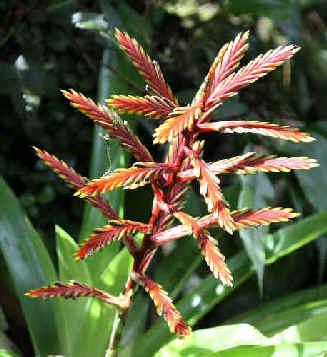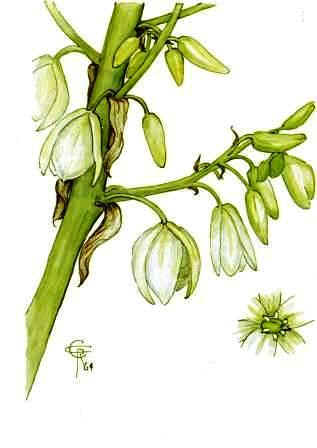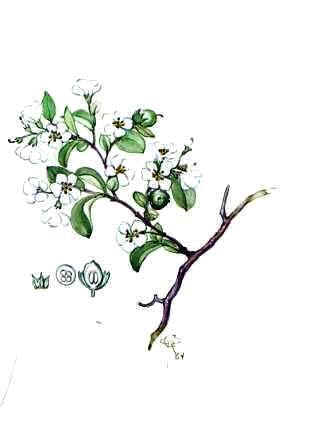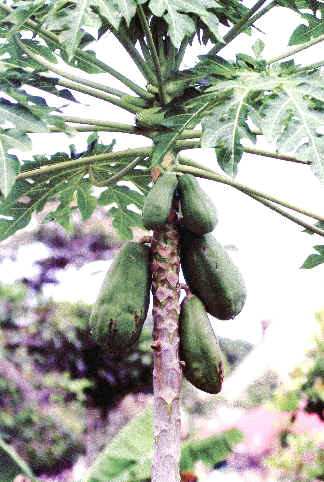
E-mail: font@focusonnature.com
Phone: Toll-free in USA 1-888-721-3555
or 302/529-1876
 |
PO
Box 9021, Wilmington, DE 19809, USA E-mail: font@focusonnature.com Phone: Toll-free in USA 1-888-721-3555 or 302/529-1876 |

Tropical Plants
of the
Americas
in Mexico, Central America
South America
and the Caribbean
with those during
Focus On Nature Tours
thru 2015
noted with an (*)
during tours in the months of
January, February, March, April,
May, July, November, and December
The 1st part of a
three-part list
of Tropical Plants of the Americas compiled by Armas Hill
Photo at upper right: a plant in the Bromeliad family, VRIESEA ZAMORENSIS,
photographed during the April 2014 FONT Tour
in southern Ecuador,
at a place where we enjoyed staying, Copalinga - a place with many birds,
butterflies,
and interesting plants. (photo by Marie Gardner)
FONT tours in the Neotropics have been
in southern Mexico, Central America, South America, and on islands
in the Caribbean.
In the list that follows, below the scientific names are names in English and Spanish (S:)
and Portuguese (P:).
The families in the list are given (mostly) in alphabetical order, and genera
within them are given alphabetically as well.
Families that are "break-offs" from other families are at times
here still with them, and may be out of alphabetical order.
Plant
families listed alphabetically by the scientific name of the family (after
CYATHEACEAE)
are in the second and third parts of this list:
TROPICAL
PLANTS OF THE AMERICAS, Part #3
(from OCHNACEAE, Wild Plane to ZYGOPHYLLACEAE, Caltrop)
Links to Plant Families in this Part of this List:
ACANTHACEAE - Acanthus
including Black
Mangrove
ADOXACEAE
including Viburnums
AGAVACEAE - Agave & Yucca (was said to be in the Lily Family - LILIACEAE) also NOLINACEAE
AIZOACEAE - Fig-marigold, or
Carpetweed ALISMATACEAE - Water-plantains
ALSTROEMERIACEAE
AMARANTHACEAE (closely related to CHENOPODIACEAE - the Goosefoots) including Epazote (Mexican Tea)
AMARYLLIACEAE - Amaryllis ANACARDIACEAE - Sumacs Including Cashew, Mango, Spanish Plum
ANNONACEAE - Custard Apples including Soursop, Custard Apple (or "Bull's Heart")
APIACEAE - Parsley, or Celery family including Cilantro, Culantro
APOCYNACEAE - Dogbanes APODANTHACEAE (some endoparasitic herbs)
ARACEAE - Aroids ARALIACEAE - Aralias ARAUCARIACEAE - Araucarias
ARECACEAE,
was PALMAE - Palms
including Macauba Palm (or
Cocoyol), Coconut
ARISTOLOCHIACEAE -
Bladderwort, Birthwort, or Pipevines ASCLEPIADACEAE - Milkweeds
ASTERACEAE. COMPOSITAE - Aster & Sunflower including Cure-for-all Sourbush, Toothleaf Goldeneye
ATHYRIACEAE - Lady Ferns
BALANOPHORACEAE BALSAMINACEAE -
Touch-me-not
BASELLACEAE (a family of herbaceous plants)
BATACEAE - Pickleweed
BEGONIACEAE BETULACEAE - Alders
BIGNONIACEAE - Bignonias, Trumpet Creepers including Calabash, Jacarandas, Tabebuia ("Ipe") Trees
BIXACEAE - Achiote, or Annato Plants
BLECHNACEAE
BORAGINACEAE - Borages BRASSICADEAE - Mustards (formerly
CRUCIFERAE)
BROMELIACEAE - Bromeliads including Pineapple, Spanish Moss BRUNELLIACEAE
BURSERACEAE - Torchwoods, or
Incense Trees BUXACEAE - Box family
CACTACEAE
- Cacti
CALOPHYLLACEAE (previously in the CLUSIACEAE, or GUTTIFERAE
family)
CAMPANULACEAE - Bellflowers including Lobelia CANELLACEAE including White Cinnamon
CANNACEAE - Canna (now includes ULMACEAE) CAPPARACEAE - Capers
CARICACEAE - Papaya Plants
including Papaya (or Pawpaw),
Wild Papaya (or Bonete)
CARYOCARACEAE (or RHIZOBOLACEAE) CELASTRACEAE - Bittersweet, or Staff-vine
CHENOPODIACEAE - Goosefoot Family
CHRYSOBALANACEAE CLETHHRACEAE
CLUSIACEAE - Clusias COCHLOSPERMACEAE
COMBRETACEAE - Bush Willows,
Combretums, Almond COMMELINACEAE - Dayflowers, or Spiderworts
CONVOLVULACEAE - Morning Glories including Sweet Potato
COSTACEAE - Costus Family
including Spiral Ginger CRASSULACEAE - Stonecrop, or Orpine Family
CUCURBITACEAE - Gourd, or Cucumbers
including Cushaw,
Calabaza (Winter Squash), Calabacita (Summer Squash, or Zucchini), Christophine
(or Chayote)
CUPRESSACEAE - Cypress, Juniper
CYCLANTHACEAE - Panama Hat Palms CYATHEACEAE - Tree
Ferns
The following families are in the second part of this
list.
The link to them is here: TROPICAL PLANTS OF THE AMERICAS PART #2
DENNSTAEDTIACEAE - Ferns DILLENIACAE - Rose
Apples DIOSCOREACEAE - Yam
EBENACEAE - Ebony and
Persimmon ERYTHROXYLACEAE - Coca
Family EUPHORBIACEAE - Spurges
Plants in
EUPHORBIACEAE include Poinsettia,
Rubber Tree, Cassava (or Tapioca)
FABACEAE -
Legume, or Pea or Bean Family, includes CAESALPINIOIDAE, the Carob Plants,
and MIMOSOIDEAE, the Mimosa Plants
FABACEAE includes: Acacias,
Groundnut (or Peanut), Pigeon Pea, Flamboyant Tree, Monkey Ladder Vine (or
Caracol), Elephant-ear (or Guanacaste) Tree, Coral Tree, Inga Trees, Ib (or
Common Lima Bean), Black Bean (or Frijoles Negro), Raintree,
Tamarind, Retama
FAGACEAE
- Oaks (in the Beech family) GENTIANACEAE -
Gentians GESNERIACEAE - Gesnerias
GOODENIACEAE - Fan-flowers HUMIRIACEAE
ICACINACEAE JUGLANDACEAE - Walnuts including
Pecan
LAMIACEAE, or LABIATAE - Mints including Pineapple Sage,
Teak
LAURACEAE
- Laurel including Cassia
Cinnamon, Avocado
LECYTHIDACEAE
- Brazil Nut plants and allies including Brazil Nut
Tree, Cannonball Tree, Monkey Pot Tree
LILIACEAE
- Lilies (including what was in AMARYLLIDACEAE, the Amaryllis
Family)
LORANTHACEAE - Mistletoes LYTHRACEAE
- Loosestrifes including Pomegranate
MAGNOLIACEAE
- Magnolias MALPIGHIACEAE
MALVACEAE - Mallows (includes BOMBACACEAE, the
Cotton Tree Plants)
MALVACEAE includes Cuipo Tree, Kapok (or
Ceiba) Tree, Hand-flower Tree, Okra, other Rose Mallows (or Hibiscus)
MARANTACEAE -
Arrowroot, or Prayer-plant Family MELASTOMATACEAE -
Melastomes
MELIACEAE - Mahogany MENISPERMACEAE
MORACEAE - Mulberry plants
MORACEAE includes Breadfruit,
Bread Nut (or Mayan Nut), Milk Tree, Strangler Fig
MUSACEAE - Banana plants, Heliconias including Banana,
Plantain
MYRICACEAE
- Wax-myrtle MYRISTICAEAE -
Nutmeg MYRSINACEAE - Myrsine
MYRTACEAE - Myrtles includes Allspice,
Guava NYCTAGINACEAE
- Four O' Clocks
includes Bougainvillea
NYMPHAEACEAE
- Water Lilies
The
following families are in the third part of this list.
The link to them is here: TROPICAL
PLANTS OF THE AMERICAS PART #3
OLACACEAE OLEACEAE - Olive, Jasmine
ONAGRACEAE - Willowherb, Evening Primrose
ORCHIDACEAE - Orchids includes
Vanilla PAPAVERACEAE - Poppies
PASSIFLORACEAE - Passionflowers
PHYLLANTACEAE PHYTOLACCACEAE - Pokeweed
PINACEAE - Pines PIPERACEAE - Pepper
PLANTAGINACEAE - Plantains (not related to the Banana)
POACEAE (or GRAMINEAE) - Grasses
including Bamboo, Rice, Corn
PODOCARPACEAE - Podocarpus POLEMONIACEAE - Phloxes
POLYGALACEAE - Milkworts
POLYGONACEAE - Buckwheats including
Seagrape, Dzidzilache Honey (Mayan)
POLYPODIACEAE - Polypod Ferns PONTEDERIACEAE - Water Hyacinth, Pickerel-weed
PORTULACACEAE - Purslanes PRIMULACEAE - Primrose PROTEACEAE - Macadamia and allies
PSILOTACEAE - fern-like plants (without roots and true leaves)
RHAMNACEAE - Buckthorns
RHIZOPHORACEAE - Mangroves and allies includes
Tea Mangrove
RUPPIACEAE - Ditch Grass
ROSACEAE - Rose RUBIACEAE - Madders including Coffee, Psychotria elata ("Hot Lips")
RUTACEAE - Citrus, or Rue
includes Lime, Sour Orange, Shaddock, Sweet Lime, Sweet Orange
SALICACEAE - Willows SANTALACEAE - Sandalwoods
(includes VISCACEAE, Mistletoes)
SAPINDACEAE - Soapberry family includes
Akee (or Aki), Guarana
SAPOTACEAE - Sapote plants
includes Star Apple, Chicle, Yellow Sapote (or Eggfruit)
SCROPHULARIACEAE - Snapdragons, or Figworts SIMAROUBACEAE
SMILACACEAE - Greenbriers
SOLANACEAE - Nightshades includes
Cayenne Pepper, various Chiles, Tomatillo, Tomato
STERCULIACEAE - Cacao plants includes
Cacao (or Cocoa) SURIANACEAE
THEOPHRASTACEAE (often placed in PRIMULACEAE) THYMELACEAE - Daphne
TURNERACEAE
(included in
PASSIFLORACEAE) TYPHACEAE - Cattail
URTICACEAE - Nettles
including Cecropias
VERBENACEAE
- Vervains, Verbanas
includes Lantana, Mexican Oregano
VIOLACEAE -
Violets VITACEAE - Grape ZAMIACEAE - Cone-palm Ferns
ZINGIBERACEAE - Ginger
ZYGOPHYLLACEAE - Caltrop includes
Jamaican Feverplant
![]()
AN
ALPHABETICAL DIRECTORY OF PLANT GENERA IN THIS WEBSITE NOTING FAMILIES
A
Photo Gallery of Plants during a FONT Tour in the Dominican Republic
with some of the photographed
plants not identified. If you can ID any, we'd greatly
appreciate.
A Photo Gallery of Plants during
some FONT Tours in Ecuador
with some of the photographed plants not identified. If you can ID any, we'd
greatly appreciate.
Codes:
BR: in Brazil BZ:
in Belize CR: in Costa
Rica CY: in the Cayman
Islands DR: in the Dominican
Republic
EC: in
Ecuador GU: in Guatemala JM: in
Jamaica MX: in Mexico
MX(YU): in the Yucatan area of Mexico
PE: in Peru PN: Panama PR: Puerto Rico
(ph): species with a photo in the FONT web-site
In this list, Spanish names follow the letter S:
Portuguese names follow the letter P:
Another code throughout the list here, (TPCR:xx),
refers to pages with a photograph of the particular species
in the book "Tropical Plants of Costa Rica, A Guide to Native and Exotic
Flora" by Willow Zuchowski, with photographs by Turid Forsyth,
2007.
Other Links:
Information about
Upcoming FONT Birding & Nature Tours:
in the Caribbean in
Central America in
South America (Brazil and Ecuador)
or by month in: 2015
2016 or:
by geographic locations worldwide
Lists and Photo Galleries in this Website of Other Nature:
Birds in: the Caribbean Central America South America (Brazil) South America (Ecuador)
A List and Photo Gallery of Hummingbirds in 2 parts
Mammals: the Caribbean Central America South America
Butterflies
and Moths in: the
Caribbean
Central America
South America
Other Lists and Photo Galleries in this website relating to
Plants:
Tropical Plants on West Indian Islands in the Caribbean
Orchids of the Americas Fruiting Plants and Others in Brazil
Wildflowers & Other Plants in Texas
Desert Plants of the Southwest US & northern Mexico
Wildflowers & Other Plants in Eastern North America, a list in 2 parts
Northern Plants in Alaska, Iceland, & the mountains of Hokkaido, Japan
(with some notes about medicinal and edible plants)
Links to Other
Lists & Photo Galleries of Plants Directory of Photos in this Website
![]()
Books that have been sources for this list include:
"Aves Brasileiras e Plantas que as Atraem" by Johan Dalgas
Frisch and Christian Dalgas Frisch, 2005
"Botanica's Pocket Orchids" by various authors, 2007
(with over 1200 species listed)
"Brazil, Amazon and Pantanal - the Ecotraveler's Wildlife Guide"
by David Pearson and Les Beletsky, 2002
"Brazilian Fruits and Cultivated Exotics" by Harri Lorenzi,
Luis Bacher, Marco Lacerda, Sergio Sartori, 2006
"Butterflies, Moths, and Other Invertebrates of Costa Rica, a
Field Guide" by Carrol Henderson, 2010
"The Butterflies of Hispaniola" by Albert Schwartz, 1989.
"Fruits and Vegetables of the Caribbean" by M Bourne, G. Lennox and
S. Seddon, 2006
"Hispaniola" by Eladio Fernandez, 2007
"Hummingbirds, a Life-size Guide to Every Species" by Michael
Fogden, Marianne Taylor, and Sheri Williamson, 2014
"A Naturalist in Costa Rica" by Alexander Skutch, 1971
"Threatened Plants of the Cayman Islands - the Red List" by
Frederic Burton, 2008.
"Tropical Plants of the World" by Jens Rohwer, 2002
"Yucatan, Recipes from a Culinary Expedition" by David
Sterling, 2014
About 50 color illustrations in this 3-part list are from the book "Flowers
of Guatemala" by Carol Rogers Chickering.
Most of the illustrations were done about 50 years ago in 1964-1965. The book
was published in 1973.
Another book that has been a valuable source for information here is "Tropical
Plants of Costa Rica, A Guide to Native and Exotic Flora" by
Willow Zuchowski, with photographs by Turid Forsth, 2007.
As noted above, the code (TPCR:xx)
in this list refers to pages with a photograph of a particular plant.
A List of
Tropical Plants
of the Americas, Part 1:
Family
ACANTHACEAE (Acanthus)
Genus
APHELANDRA








































